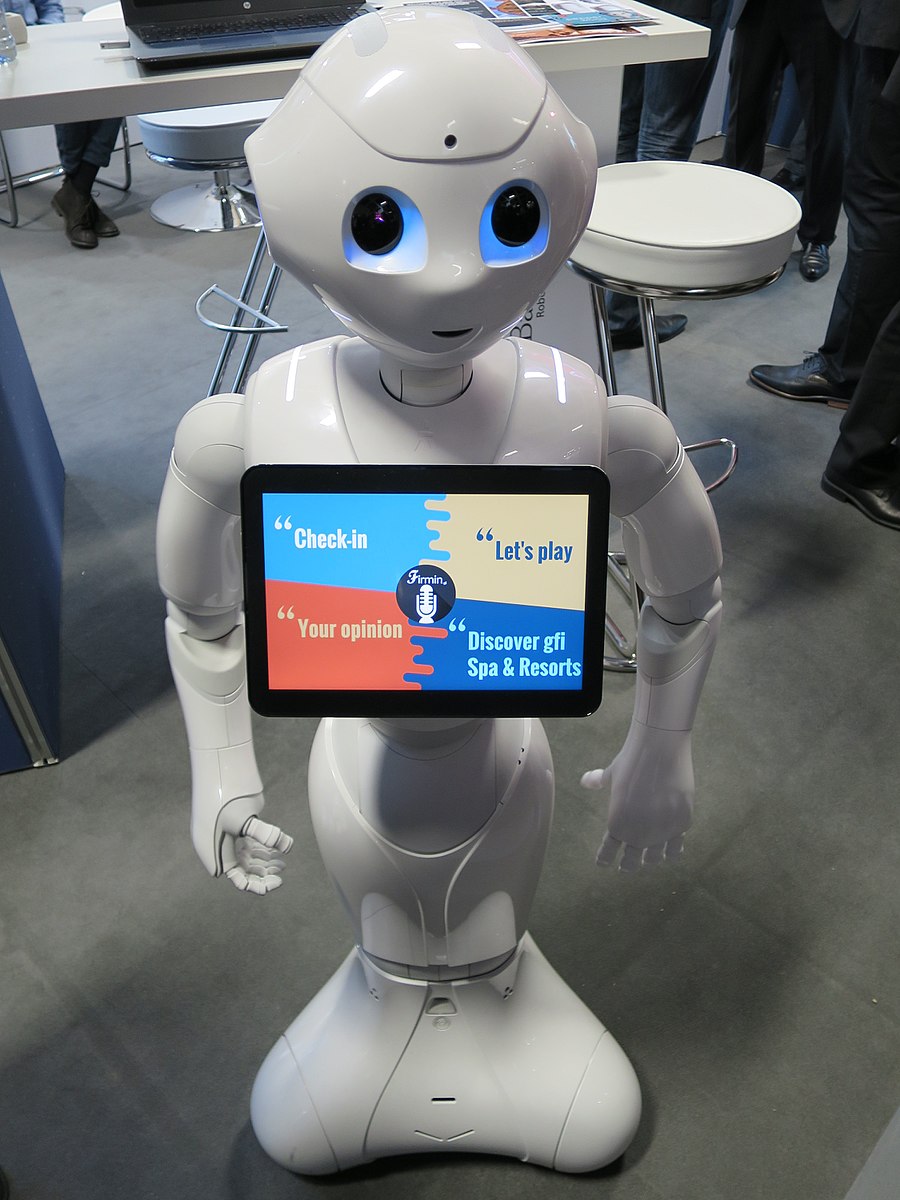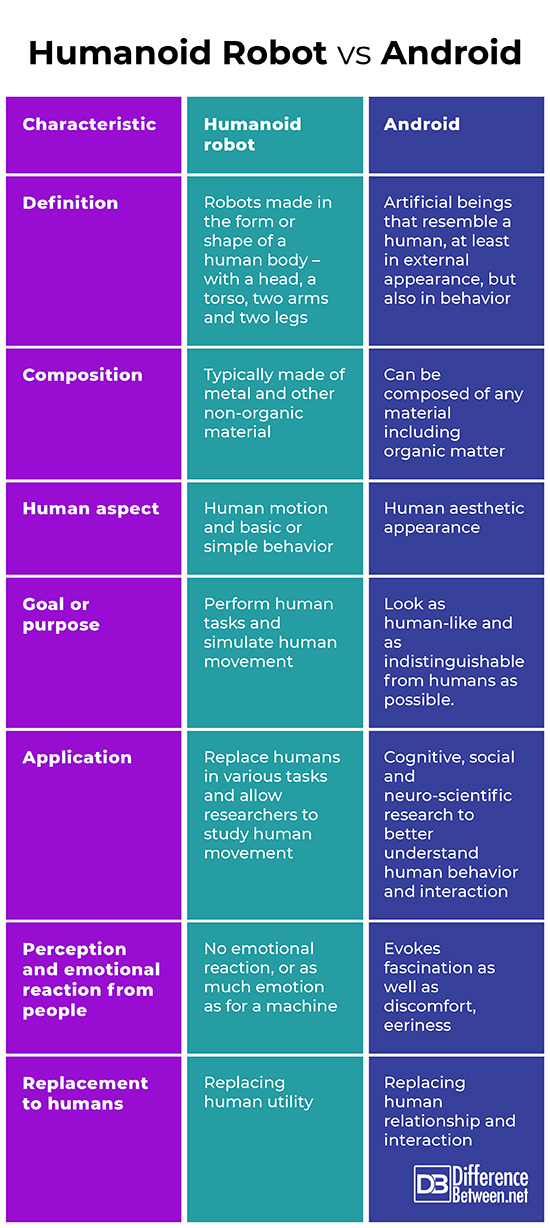Difference Between Humanoid Robot and Android
Humanoid robots and androids are two types of artificial creations that resemble humans. Although fundamentally different, the line between the two is becoming blurry mainly because of portrayal in science fiction and popular culture. Still, science fiction and real life are mostly the same in how humanoid robots and androids are differentiated.
The main difference between the two is the degree to which they mimic humans. Another difference is the purpose as to why they are built. A curious difference between the two, as demonstrated in research, is the emotional reaction that people have towards humanoid robots and androids. More about these two artificial constructs and their differences are discussed further below.

What is a Humanoid Robot?
A humanoid robot is a robot with its body made in the shape or form of a human body – that is, a head, a torso, two arms and two feet. Some authors make a distinction for those robots similar in upper body only, with the feet being replaced by some other form of locomotion such as wheels, but most agree that such robots are still humanoid. Like most robots, humanoid robots are usually made of metal or other non-organic material.
Humanoid robots are typically made to mimic human motion and simple behavior. This mimicry not only allows humanoid robots to perform tasks that a human can do but also helps researchers know more about human motion and behavior. As the capability of humanoid robots increase, its applications become more widespread. Humanoid robots are now often designed to replace humans in dangerous jobs as well as repetitive tasks. The study of human motion has also helped the medical field in building better and more functional prosthesis and orthosis. Although people rightly perceive them as machines, there is a growing fear, as with all robots, that as these machines are built better and better, humans will become obsolete in terms of tasks and jobs, leading to an existential crisis of meaning and purpose.

What is an Android?
An android is an artificial being that looks aesthetically like a human. Until recently, androids have been described only in science fiction but advancements in robotics have seen the creation of real life androids and its female counterpart, gynoids. Androids are currently defined based on the technology they are made of, that is mostly robotic internal mechanisms and a lifelike human exterior made of synthetic flesh-like material. This composition, along with depictions in popular culture, leads many to classify androids as just more humanoid robots. In theory however, androids are not necessarily robotic or mechanical, and can be composed of any material, both organic and non-organic. This leads to the goal-based definition which is that androids are designed to be “indistinguishable from humans in its external appearance and behavior.”
Androids are typically designed to mimic human appearance first and foremost. This is why androids are designed to be as humanlike as possible, using robotics and synthetic flesh that allow facial expressions in combination with the most advanced artificial intelligence capable of conversation. This human likeness usually evokes fascination but coupled with the certainty that an android is artificial, it also gives a feeling of discomfort and eeriness that extends to fear in some people. This ability of androids to evoke emotion led to its critique and application. A new branch of science called android science has emerged, using androids as experimental tools in cognitive, social and neuroscientific research. These fields of science study human behavior and interaction. This new field hopes, at the very least, to help humanity understand what makes it human. The critique on the other hand is that there is a fear that androids will replace humans in relationships, and will prefer the company of robots than that of other humans.
Difference between Humanoid Robot and Android
Definition
Humanoid robots are robots made in the form or shape of a human body – with a head, a torso, two arms and two legs. Androids are artificial beings that resemble a human, at least in external appearance but also in behavior.
Composition
Humanoid robots are typically made of metal and other non-organic material. Real life androids are basically humanoid robots in composition but in theory, they can be composed of any material including organic matter.
Human aspect being mimicked
Humanoid robots mimic human motion and basic or simple behavior. Androids mimic human appearance primarily.
Goal or purpose
The main purpose of humanoid robots is to perform human tasks and simulate human movement. Androids are designed to look as human like as possible.
Application
Humanoid robots can replace humans in various dangerous and repetitive tasks as well as allow researchers to study human movement further to develop better prosthetic and orthotic technology. Androids can be used in cognitive and social research to better understand human behavior and interaction.
Perception and emotional reaction of people
Humanoid robots typically do not raise any emotional reaction as they are perceived as machines. Androids however are perceived as a human likeness and clearly evoke both fascination and discomfort.
Replacement to humanity
Humanoid robots are seen as replacements to human utility, with tasks being performed by robots. On the other hand, androids are seen as replacements to human relationship and interaction, with people preferring androids for company rather than other humans.
Humanoid robot vs Android

Summary
- Humanoid robots and androids are similar in that they are artificial beings made in the likeness of humans. Humanoid robots are made in the shape of humans – that is they have a head, a torso, two arms and two legs.
- Real life androids are basically humanoid robots but are more aesthetically human, with more realistic features. An android’s resemblance to humanity is its defining characteristic. In theory, androids are not necessarily robots. They are artificial but can still be made of organic material.
- Difference Between Hematoma and Melanoma - February 9, 2023
- Difference Between Bruising and Necrosis - February 8, 2023
- Difference Between Brain Hematoma and Brain Hemorrhage - February 8, 2023
Search DifferenceBetween.net :
1 Comment
Leave a Response
References :
[0]Image credit: https://pixabay.com/de/illustrations/android-smartphone-logo-roboter-1693894/
[1]Image credit: https://commons.wikimedia.org/wiki/File:Humanoid_Robot_(2)_ITB_2017.JPG
[2]Hornyak, Tim. "Android Science." Sceientific American. May 1, 2006. https://www.scientificamerican.com/article/android-science/ (accessed November 4, 2019).
[3]MacDorman, Karl F., and Hiroshi Ishiguro. "The uncanny advantage of using androids in cognitive and social science research." Interaction Studies, 2006: 297-337. Print.
[4]Wagstaff, Keith. "What If the Robot Utopia Leads to an Existential Crisis for Humans?" VICE. April 25, 2016. https://www.vice.com/en_us/article/mg7bvq/what-if-the-robot-utopia-leads-to-an-existential-crisis-for-humans (accessed November 4, 2019).
[5]Woychowsky, Edmond. "The difference between robots and androids." TechRepublic. April 133, 2010. https://www.techrepublic.com/blog/geekend/the-difference-between-robots-and-androids/ (accessed November 4, 2019).

It’s Explaintion satisfy me . I understand difference between robot & humanoid properly. Thanks